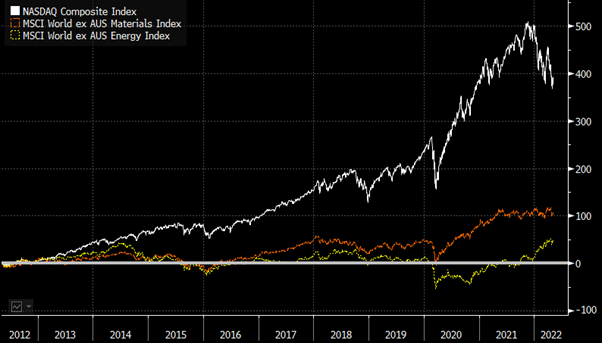The topic on everyone’s mind is: what does the balance of 2022 have in store for investors?
It looks like 2022 will continue to be a difficult year for equity investors, as the market experiences considerable volatility but ultimately ‘treads water’ and consolidates. In April, there were not many places for investors to hide, with the S&P500 Index down 8.8% and the Nasdaq down 13.3%, bond markets also weak (US 10-year yields up 53bp for the month to 2.85%) and gold down 2%.
Inflation bites
Meanwhile, the most recent Australian CPI inflation number surged to 5.1%. For anyone renovating (or who knows someone who is), it comes as little surprise that a key upward driver was housing construction costs as well as higher fuel prices. The US CPI came in at 8.5% for March year on year on its way to 10% and beyond, potentially challenging the highs we had in 1970-1980. Once the inflation genie springs from the bottle it’s hard to stuff back in. Back in the 70s it took a rotation of three individual US Federal Reserve Chairs to tackle inflation: it was only when Volcker took the helm in 1979 and drove the federal funds rate to 20% that inflation finally broke – along with the global economy. This time we think the Fed will not repeat its past mistakes, and inflation will be tackled faster.
That won’t be easy, however, as inflation is already becoming entrenched. Coles recently reported food inflation in the March quarter of 3.3% and suggested that price rises were only just getting started. Higher energy prices lead to higher food prices, and energy has just gone through a decade of depressed spending in new and expanded production: there simply is not enough oil and gas to satisfy global needs, particularly as sanctions continue to be placed on Russia. Our view is that oil prices have not seen their top, notwithstanding the Brent oil price is currently sitting 60% higher than 12 months ago.
The following chart shows the outperformance of the technology sector over the energy and materials sectors. The NASDAQ has beaten the global energy and materials sectors by a factor of 4 over the past decade. However, given the tech sector’s long-dated earnings profile with rapidly rising interest rates, we believe this gap in performance will close.

Interest rates on the up
The Fed has already raised interest rates twice this year, and the market is forecasting two more 50bps rises in June and July followed by a rate hike every meeting for the remainder of the year. The only thing that could halt that trajectory is if US summer economic data is so weak that a pause in hikes is considered. We saw the US equity market fall 6% during the US Fed’s taper program in 2013 and the US Fed quickly reversed course – though that may not be as easy this time, with Powell’s mandate being to tame inflation. In the meantime, as equity markets rise the Fed will take every rate hike it can get.
The Reserve Bank of Australia took the opportunity to raise rates by 25bp to 0.35% at its May meeting, above market expectations. The rate increase was immediately passed on in full by each of the major banks. It has been a long time since Australians have experienced rising home loan rates (11 years, in fact) and we expect a considerable impact on consumer discretionary spending as belts are tightened. Former Australian Prime Minister Malcolm Fraser once said “life wasn’t meant to be easy” and we think the Australian consumer is about to find out just how hard life can be in a rising interest rate environment. The consumer discretionary sector of the Australian market is down 15% already this calendar year, and that’s before many of its constituents have downgraded profit expectations (which we expect to occur over the next 12 months).
The benefit of a long short capability
We do not expect the Australian equity market to produce significant returns for investors this calendar year.
Notwithstanding, Kardinia has the added flexibility of shorting which many managers in Australia do not possess. In the last 2020 pandemic equity market sell off, the ability to short individual shares and the market resulted in Kardinia falling only c.4% when the market fell c.36%.
For a long short fund there are opportunities on both the long and short side to make a return in these markets. So how does that translate into the portfolio?
- With a global economic slowdown within the next 12 months a real possibility, household budgets will continue to squeeze. We believe consumer discretionary stocks are at risk.
- Big capitalisation companies should outperform the small caps.
- We like the resource and energy sectors and are leveraged to food inflation including Woolworths.
- We have reduced our net exposure to c.10% and our short book has materially grown in both the number of shorts and individual sizes.
Our key exposures are currently long consumer staples and inflation beneficiaries such as oil, resources (including ‘green’ metals); and short high multiple stocks, long duration earnings stories and loss makers.
Equity Trustees Limited (“Equity Trustees”) (ABN 46 004 031 298), AFSL 240975, is the Responsible Entity for the Kardinia Long Short Fund (“the Fund”). Equity Trustees is a subsidiary of EQT Holdings Limited (ABN 22 607 797 615), a publicly listed company on the Australian Securities Exchange (ASX: EQT).
This publication has been prepared by Kardinia Capital Pty Ltd to provide you with general information only. In preparing this information, we did not take into account the investment objectives, financial situation or particular needs of any particular person. It is not intended to take the place of professional advice and you should not take action on specific issues in reliance on this information. Neither Kardinia Capital Pty Ltd, Equity Trustees nor any of its related parties, their employees or directors, provide and warranty of accuracy or reliability in relation to such information or accepts any liability to any person who relies on it. Past performance should not be taken as an indicator of future performance. You should obtain a copy of the Product Disclosure Statement before making a decision about whether to invest in this product.

